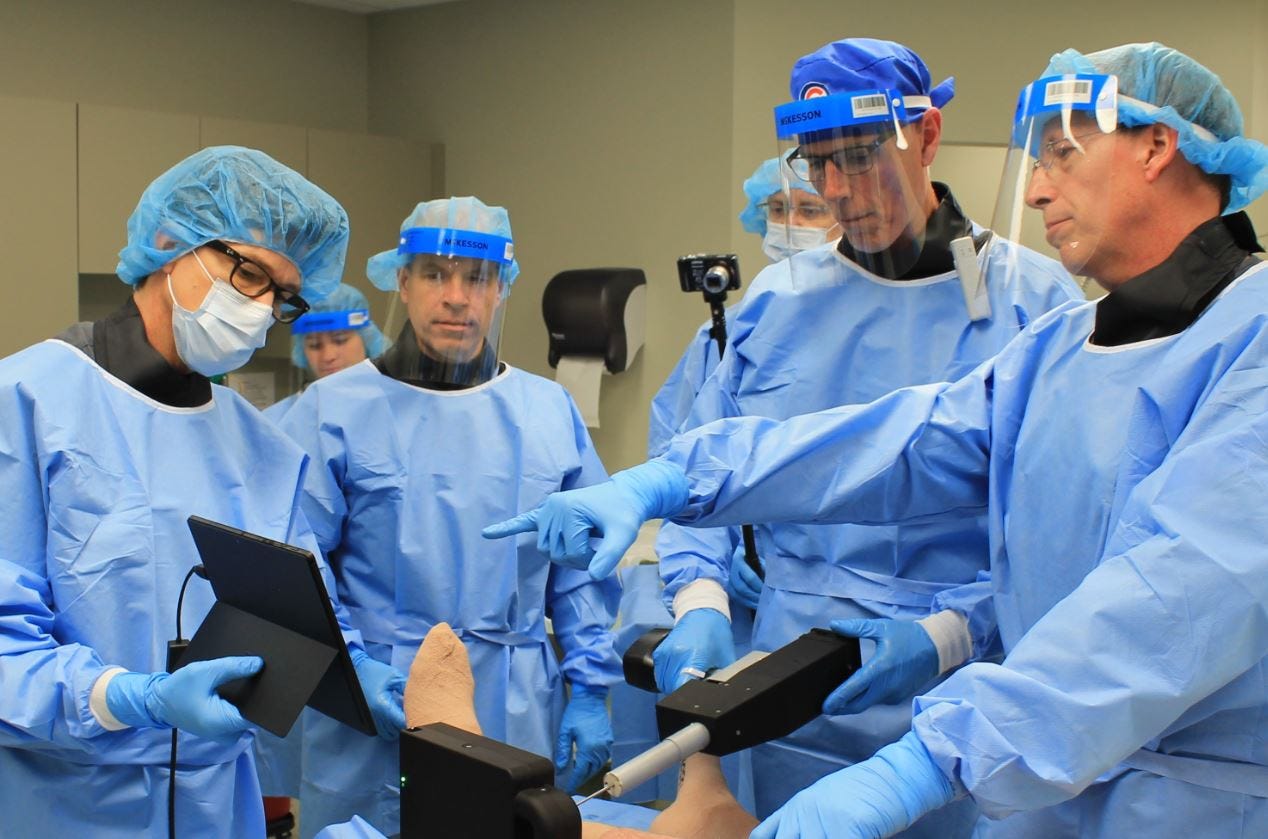Seed Funding Boosts Ortho Drill Technology
 The technology involves an x-ray attachment for the surgeon's drill that Eclipse says allows the surgeon to "see" where he or she is drilling.
The technology involves an x-ray attachment for the surgeon's drill that Eclipse says allows the surgeon to "see" where he or she is drilling.
Subscriber Benefit
As a subscriber you can listen to articles at work, in the car, or while you work out. Subscribe NowA Warsaw-based orthopedic startup says it has a solution to one of the most difficult tasks orthopedic surgeons face when repairing a traumatic injury, such as a fractured tibia or femur, the major leg bones. While trauma surgeons are practiced and proficient at distal locking, Eclipse Orthopaedics founder and Chief Executive Officer David Rich says general orthopedic surgeons have a much harder time with the delicate step; it involves—somewhat blindly—drilling pilot holes to insert a nail that stabilizes a break. Boosted by a recent $400,000 round of seed funding, the startup says it’s one step closer to commercializing its device to help surgeons—for the first time—“see” where they’re drilling.
“Some people…consider this one of the last remaining big problems in orthopedic trauma, is how to engineer something that makes this step easier to do,” says Rich.
Distal locking involves putting a rod down the middle of the bone to repair a fracture.
“There’s one step in [the surgery] where the surgeon puts the screws through the bone and through holes that are drilled in the rod. The surgeon has to drill pilot holes through the bone and through the pre-drilled holes in the rod while he can’t see those holes; it’s a bit like trying to hit a particular spot in the stud that’s hidden behind a wall, and you don’t have a good way of looking at it,” says Rich. “Trauma specialists are really good at it, because they end up doing many such surgeries per year. But most surgeons that are called on to do this are not trauma specialists; they’re general practitioners.”
Rich says, currently, these general practitioners “sweat the bullets” to get the job done; the cumbersome step involves using a giant C-shaped fluoroscopy machine that wraps around the patient’s body to provide real-time x-ray imaging during surgery. The surgeon positions the drill bit in the image where he plans to drill, then the machine must be moved.
“It’s not possible right now for the surgeon to be able to see the hole and drill through it at the same time; he can either see the hole, or he can drill, but he can’t do both at the same time,” says Rich.
Eclipse Orthopaedics says its device, called the Radiographic Targeting Attachment (RTA), allows surgeons to do both.
“We have put an x-ray source on the drill and created a vision system that allows them to look at the hole and drill through the hole at the same time,” says Rich. “The surgeon is able to take his ordinary surgical drill, put this attachment on it, and while he’s using it, he can see through the bone and see the hole in the rod that he needs to hit.”
Rich says, in addition to simplifying this complicated step for surgeons, it also saves time, which means the surgical team would be exposed to less radiation during the procedure. Rich believes patients also would no longer need to travel to larger cities in search of a trauma specialist to perform the surgery.
“We’re excited about the opportunity to help surgeons who aren’t specialists,” says Rich, “giving them a tool that makes their job easier and makes the total surgical result more like what the patient would have at a Level 1 trauma center.”
Eclipse has been working with a team of Indiana surgeons to perfect the device. The startup recently closed on a $400,000 seed round of funding, led by Indianapolis-based Elevate Ventures.
“[The funding] is a tremendous boost to our ability to create the prototypes necessary to show we can reduce the radiation and prove out the benefits of [the device] being safer, faster and easier for a bigger group of surgeons,” says Rich. “It puts us down the road of making the next prototype and then getting started on the testing involved.”
The startup earned a SBIR/STTR Phase 1 grant from the National Institutes of Health in 2018, and Rich is hopeful Eclipse’s next chapter will include a Phase 2 grant and an important partnership.
“My strategy is to capture the interest of one of the major orthopedic companies to help develop this,” says Rich. “This product is a tool that helps the surgeon install implants, so it needs to be sold, delivered and marketed by an implant company…to be the most helpful to the most people.”
Rich is hopeful the device will be on the market in two to three years, giving surgeons newfound vision into a notorious “blind spot.”
Rich says, in addition to providing seed funding, Elevate Ventures’ guidance has helped him learn how to be an entrepreneur.
Rich says the startup will focus next on building a new prototype and working toward regulatory approval.
